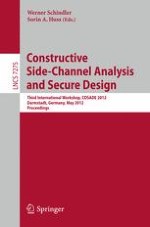2012 | Buch
Constructive Side-Channel Analysis and Secure Design
Third International Workshop, COSADE 2012, Darmstadt, Germany, May 3-4, 2012. Proceedings
herausgegeben von: Werner Schindler, Sorin A. Huss
Verlag: Springer Berlin Heidelberg
Buchreihe : Lecture Notes in Computer Science
